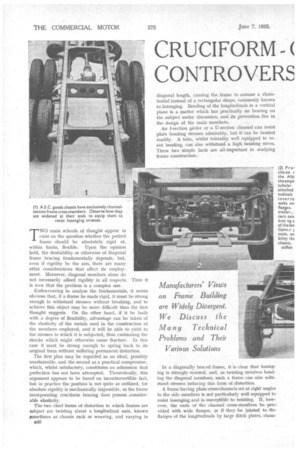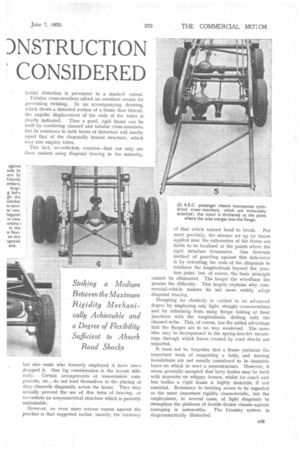CRUCIFORM CONTROVERS )NSTRUCTION CONSIDERED
Page 46

Page 47

If you've noticed an error in this article please click here to report it so we can fix it.
TWO main schools of thought .appear to exist on the question whetherthe perfect frame should be absolutely, rigid or, within limits, flexible. Upon the opinion held, the desirability or otherwise of diagonal frame bracing fundamentally depends, but, even if rigidity be the aim, there are many other considerations that affect its employMent., Moreover, diagonal members alone do not necessarily afford rigidity in all respects. Thus it is seen that the problem is a complex one.
Endeavouring to analyse the fundamentals, it seems obvious that, if a frame be made rigid, it must be strong enough to withstand stresses without breaking, and to achieve this object may be more difficult than the first thought suggests. On the other hand, if it be built with a degree of flexibility, advantage can be taken of the elasticity of the metals used in the construction of the members employed, and it will be able to yield to the stresses to which it is subjected, thus cushioning the shocks which might otherwise cause fracture. In this case it must be strong .enough to spring back to its original form without suffering permanent distortion.
The first plan may be regarded as an ideal, possibly unattainable, and the second as a practical compromise, which, whilst satisfactory, .constitutes an admission that perfection has not been attempted. Theoretically, this argument appears to be based on incontrovertible fact, but in practice the position is not quite as outlined, for absolute .rigidity is mechanically impossible, so the frame incorporating cruciform bracing does possess consider able elnsticity-. .
The two chief forms of distortion to which frames are subject are twisting about a longitudinal axis,known sometimes as chassis rack or weaving, and varying in B82 diagonal length, causing the frame to .assume a rhomboidal instead of a rectangular shape, commonly known as lozenging. Bending of the longitudinals in a vertical plane is a matter which has practically no bearing on the subject under discussion, and its prevention lies in the design of the main members.
An I-section girder or a U-section channel .can resist plain bending stresses admirably, but it can be twisted readily. A tube, whilst tolerably well equipped to resist bending, can also withstand a high twisting stress. These two simple facts are all-important in studying -frame construction..
In a diagonally braced frame, it is clear that lozenging is strongly resisted, and, as twisting involves bending the diagonal members, such a frame can also withstand stresses inducing this form of distortion.
A frame having plain cross-channels set at right angles to the side members is not particularly well equipped to resist lozenging and is susceptible to twisting. If, however, the ends of the channel cross-members be pro-g vided with wide flanges or if they be Jointed to the flanges of the longitudinals by large flitch plates, rhom boidal distortion is prevented to a marked extent.
Tubular cross-members afford an excellent means for preventing twisting. In an accompanying drawing, which shows a distorted section of a frame thus braced, the angular displacement of the ends of the tubes is clearly indicated. Thus a good, rigid frame can be built by combining channel and tubular cross-members, but its resistance to both forms of distortion will hardly equal that of the diagonally braced structure, which may also employ tubes.
This fact, nevertheless, remains—that not only are those makers using diagonal bracing in the minority, but also some who formerly employed it have since dropped it. One big consideration is the layout difficulty. Certain arrangements of transmission components, etc., do not lend themselves to the placing of deep channels diagonally across the frame. They may actually prevent the use of this form of bracing, or necessitate an unsymmetrical structure which is patently undesirable.
However, an even more serious reason against the practice is that suggested earlier, namely, the tendency
of that which cannot bend to break. Put
more precisely, the stresses set up by forces applied near the extremities of the frame are liable to be localized at the points where the rigid structure terminates. One first-rate method of guarding against this deficiency is by extending the ends of the diagonals to reinforce the longitudinals beyond the junc tion point, but, of course, the basic principle cannot be eliminated. The longer the wheelbase the greater the difficulty. This largely explains why com mercial-vehicle makers do not more widely adopt diagonal bracing.
Designing for elasticity is carried to an advanced degree by employing only light, straight cross-members and by refraining from using flange bolting at their junctions with the longituclinals, drilling only the
channel webs. This., of course, has the added advantage thAt the flanges are in no way weakened. The same idea may be incorporated in the spring-bracket mountings, through which forces created by road shocks are
imparted.
It must not be forgotten that a frame performs the important work of supporting a body, and moving foundations are not usually considered to be desirable bases on which to erect a superstructure. However, it seems generally accepted that lorry bodies may be built with impunity on whippy frames, whilst for coach and bus bodies a rigid frame is highly desirable, if not essential. Resistance to twisting seems to be regarded as the more important rigidity characteristic, but the employment, in several cases, of light diagonals to strengthen the platform of double-decker chassis against lozenging is noteworthy. The Crossley system is diagrammatically illustrated.




























































































